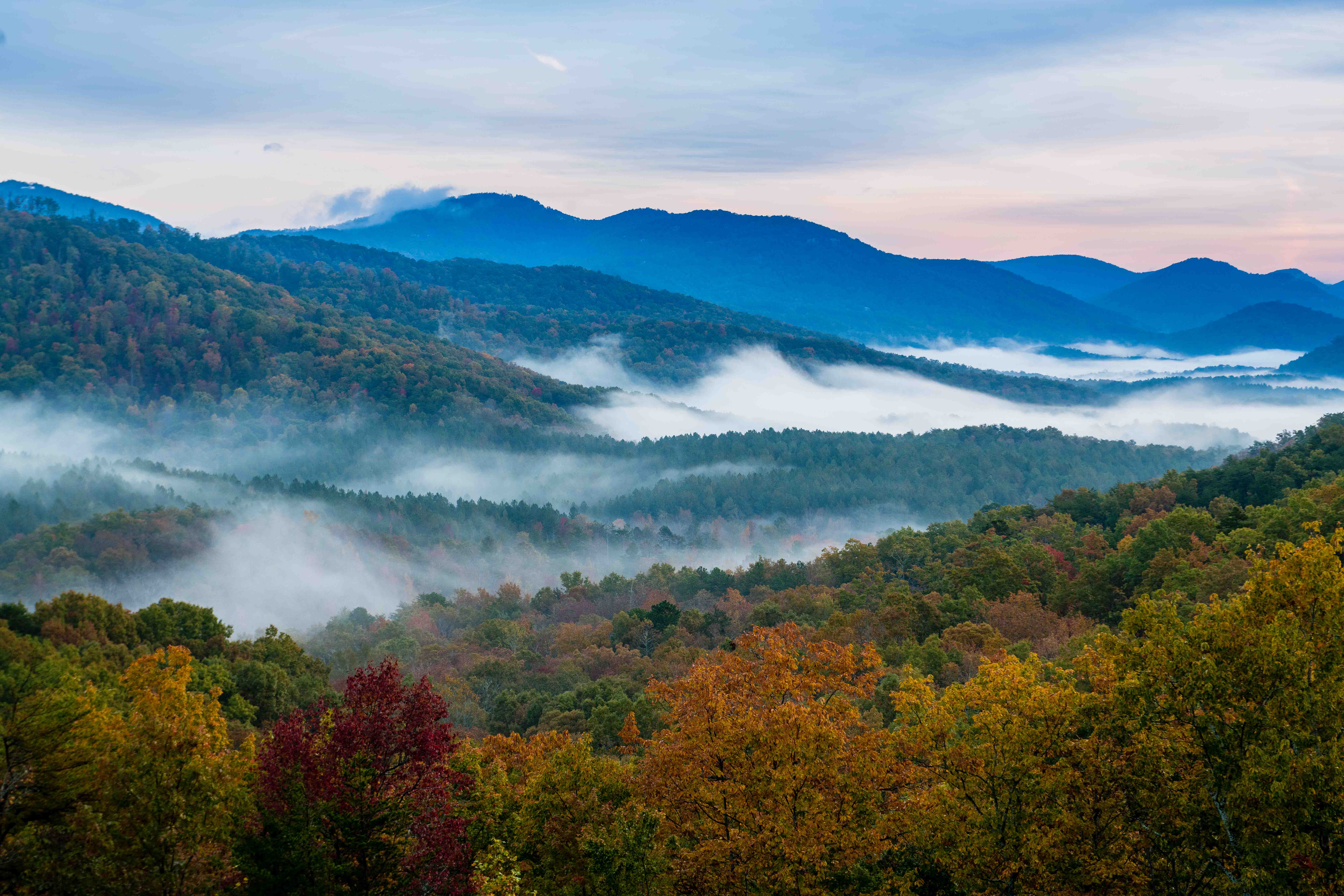The Cliffs celebrates and cultivates its rich, biodiverse surroundings
On a particularly stunning spring morning, Greg Prisk hikes along one of the numerous trails that wind through The Cliffs at Keowee Falls. Here is what he sees: “Ferns, all sorts of trees, which I wish I could identify — maples, oaks, pines — and dappled light, which I absolutely love.”
He stops to take a photo of moss-covered stones that shine like rock stars under the sun’s spotlights: “Mountain laurel, which has just peaked here. Root systems that are 2 to 3 inches thick …”
Asked whether the area’s natural beauty helped attract him and his wife, Janet, to The Cliffs, he says, “That was a very large component; it’s the single largest by far.”
The couple, married for nearly 27 years, moved to The Cliffs at Keowee Falls in 2017. Both fell in love with the community’s 2,500 acres of dense forests and cascading waterfalls.
This morning, moving along on his solo trek, Prisk lets out a whistle-sigh — sswhew — that underscores just how breathtaking he finds his surroundings.
“Some people say woods are woods, but, to me, it’s really inspirational,” he says. “I can enjoy going to one of the other six communities. And I can’t count just how many places there are to go hiking around here.”
Jake Wickiser, Outdoor Pursuits Manager for The Cliffs Mountain Region, is very familiar with ample hiking opportunities. He leads members on weekly hiking and mountain biking excursions where he enjoys pointing out wildlife.
Along those hikes, Wickiser frequently spots canopies of blooming rhododendron, ground cedar spread “as far as the eye can see,” and his personal favorite: ferns. “We see many different varieties of fern on our adventures, from small-leaf to larger-leaf variants,” he says. “Many members have been able to transplant ferns from deep in the wilderness to closer to their homes.”
In summer months, hikers can find bright orange, trumpet-style mushrooms called chanterelles. These mushrooms, considered a delicacy by many, are found near decaying or fallen wood. Wickiser says he’s foraged more than 20 pounds of chanterelles, and even gifted some to the executive chefs at Mountain Park.
As for animals seen along the trails, Wickiser says he’s personally seen bears, deer, wild boar, and bobcats. The region’s critters also include the likes of turkey, grouse, songbirds, and thousands of species of amphibians, reptiles, invertebrates, and small mammals, according to the U.S. Department of Agriculture’s Natural Resources Conservation Service.
More specific to communities at The Cliffs in and around Upstate South Carolina and Asheville, North Carolina, Appalachian cove hardwood forests “represent some of the most diverse ecosystems in the world outside of tropical zones,” the North Carolina Wildlife Resource Commission says.
This ecosystem is the perfect environment for one of the rarest wildflowers in the world: the Oconee Bell. Found only in the southern Appalachian Mountains, the low-growing evergreen blossoms with white or pink bell-shaped flowers each spring and thrives in shaded, moist banks or rocky outcrops, according to the South Carolina Parks Department.
For all of this natural largesse, we have to thank rain, says R. Graham Reynolds, associate professor of biology at the University of North Carolina Asheville.
As much as 70 inches of it falls annually, depending on where you live around here, according to the South Carolina State Climatology Office and, for North Carolina, the National Weather Service.
“Rain matters because that’s going to determine a lot — not just the hydrology, but the environments that are found in those areas,” Reynolds says.
He points to The Cliffs at Walnut Cove, just 15 miles south of Asheville. “It’s no accident that the places people like the most are where it still rains so much. That’s part of the draw,” he says. “The reason why Asheville is great is that we’ve got access to all these natural areas that are supported by varying levels of rainfall. It comes with the territory in the sense that the rain generates diversity, which generates the kinds of habitats we enjoy.”
Howard Gutenstein is drawn to water. As much as he says he loves the enveloping flora and fauna, it’s the fishing that lures him to relaxation virtually at his doorstep at The Cliffs at Keowee Falls.
Gutenstein works remotely—37 years in IT—so when he wants to take a break, he simply steps down to the dock and throws a line into Lake Keowee. He has seen beavers, river otters, and giant turtles, really big turtles, he says. And he can go fly fishing in the abundance of lakes, rivers, and streams, some just five minutes from home.
“I like being in the midstream, in the woods. You’ll sit there, and see a bear walk by, or something like that if you’re doing it right. The animals don’t even notice. It’s great,” he says.
The angling opportunities, he says, provide an amenity as valuable as all of the others available to every member at The Cliffs in every community.
For Prisk, that means that while he may not be all that into golf, the 9th and 10th holes on the Keowee Falls course happen to be fine fishing holes.
“I’m a recharge guy by being out in nature, period,” says Gutenstein, a catch-and-release guy as respectful of the environment as The Cliffs’ entire operation strives to be.
Matt Arrington is Director of Landscaping at The Cliffs at Keowee Falls and The Cliffs at Keowee Springs. For the past seven years, he has managed a staff of around 20 who work to enhance what nature provides, providing the human touch with thoughtful landscaping.
For instance, around the Keowee Falls clubhouse, he and his team are adding black-eyed Susan, coneflowers, Shasta daisies, milkweed, and other vibrant, distinctive, and indigenous perennials. That effort blooms with “more color,” he says, “which obviously attracts the bees and butterflies, which a lot of our members appreciate seeing.”
Arrington, who started in his father’s landscaping business when he was 12 and now brings with him 20-plus years of experience, applauds the in-house experts who add to the crew’s initiatives.
“We pride ourselves on using proper horticulture techniques,” he says.
Arrington notes that even proper hedge trimming makes a world of difference in shaping the environment around facilities at The Cliffs.
UNCA’s Graham comments on that attention to detail.
“When communities have master planning to them, which The Cliffs does, they can leverage their ability to include features that preserve the natural environment,” he says, noting “simple things, like hiking and biking trails that really allow residents and visitors to enjoy the kinds of habitats that are there.”
Dale Wilde is now in her third year as president of the Friends of Lake Keowee Society, a nonprofit organization marking its 30th anniversary this year. With its motto, ACE, which stands for Advocacy, Conservation, and Education, FOLKS boasts 900-plus members. Among them are residents at The Cliffs Howard Gutenstein, who serves as vice president, and Greg Prisk, a board member.
“The Cliffs and many of the communities on the lake work hand-in-hand in preserving the lake,” Wilde says. “They really are committed to keeping this lake pristine.”
After all, she says, “We all adopted this area one way or the other. We weren’t the first people here, probably not going to be the last.”
This story was featured in Cliffs Living magazine. To see more stories like this one and learn more about The Cliffs, subscribe here.

